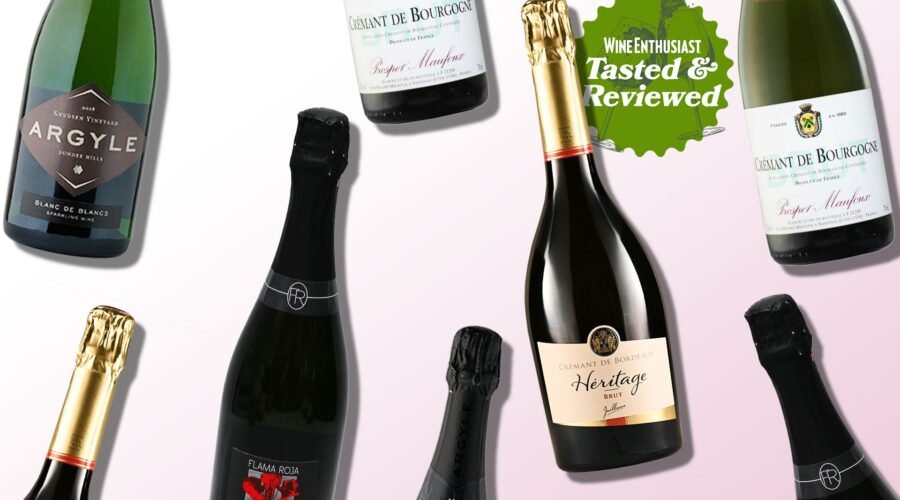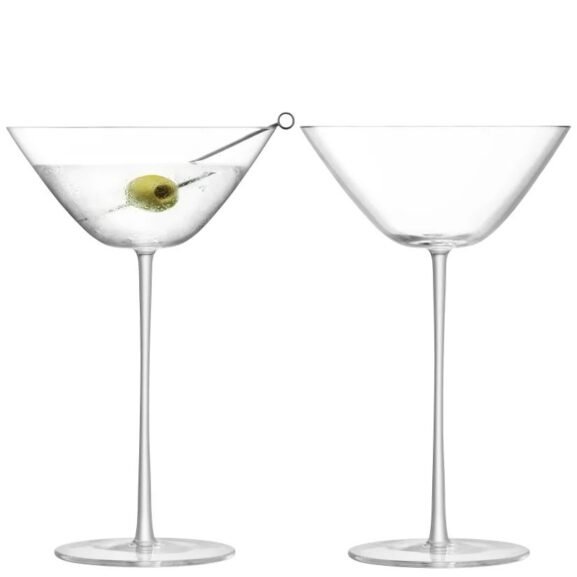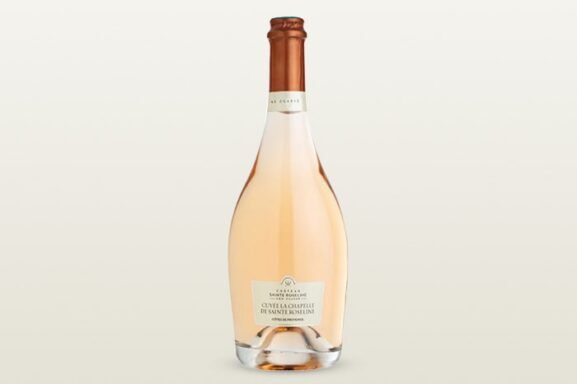Ratings: Feeling Bubbly? 16 Sparkling Wines to Pop Right Now
There’s not enough said about the vastness of the sparkling wine category. Understanding its nuances can lead one down a bubbly rabbit hole: The grape varieties used, production method choices, aging requirements and seemingly endless additional factors that can tremendously impact the final drinking experience.
Chris Gaither, master sommelier and wine director at Ungrafted and GluGlu in San Francisco, explains that regardless of the type of sparkling wine, all purposefully have a high amount of carbon dioxide trapped inside their bottles.
“There are two popular styles derived from the method of fermentation and aging: traditional method and Charmat method,” he says. The traditional method is synonymous with Champagne, though it is used all over the world today to make high-quality sparkling wine. “The traditional method requires that a [fermented base wine] undergoes a second fermentation in the same bottle it will be sold in,” Gaither explains. That secondary fermentation is what causes carbon dioxide—in other words, bubbles—to be trapped within the bottle.
On the other hand, the Charmat method also involves a secondary fermentation, though it takes place in a large, pressurized tank rather than individual bottles. “This helps to preserve the fresh fruit aromatics of the sparkling wine, and doesn’t require long periods of aging,” Gaither explains. This is also the go-to method for producing the majority of Proseccos. “This style of sparkling wine is also quite popular, as it is less expensive and much easier to produce compared to traditional method bubbly.”
Take a Deeper Dive: Your Guide to Becoming an Expert on Sparkling Wine
Of course, any conversation about sparklers must include mention of méthode ancestrale, or pét-nat. This technique differs from the traditional method in that the wine is only partially fermented before bottling. This one and only fermentation continues in the bottle, which produces carbon dioxide. The result is a pleasing effervescence, often ready for sipping only after a short few months of rest.
What bubbles are most worth your attention? Here are the top effervescent wines to drink right now, as determined by Wine Enthusiast’s Tasting Department.
Best Champagne
Best Crémant de Bordeaux
Best Crémant de Bourgogne
Best Crémant d’Alsace
Best American
Dr. Konstantin Frank 2019 Brut (Finger Lakes)
This is a smartly made traditional method fizz from one of the Finger Lakes’ most respected producers. Lovely layers of aromas, from gilled apple and honeyed pear to florals and white spice open on the rich, toasty nose. Lively bubbles and racy acidity leap from the glass at first sip. There’s tangy fruit, textural interest and excellent length. It is, frankly, delicious. Editor’s Choice. 94 Points — Christina Pickard
$ Varies
Wine-Searcher
Best Prosecco
Best Italian (Franciacorta; non-Prosecco)
Best Cava
Best Rosé
Best Blanc de Blancs
Best Blanc de Noirs
Best Nature (no added sugar)

Mosnel NV Brut Nature Sparkling (Franciacorta)
The focused nose of this sparkling wine is very intriguing with its interplay between lemon rind, green apple skin, crystallized ginger and a salty minerality. Laser-focused acidity keep the wine fresh with tart orchard fruits and citrus with hints of lees aging on the finish. This wine could surprise you with a nap in the cellar. Drink now–2035. Editor’s Choice. 93 Points — J.P.
$ Varies
Wine-Searcher
FAQs
What Makes Champagne Different from Other Sparkling Wines?
To some, no sparkling wine is grander than Champagne. Catherine Fallis, master sommelier at the wine club Bright Cellars, is one such believer. She describes Champagne as the “pinnacle” of sparkling wine because of its grapes’ dramatic growing conditions and its highly controlled, technically specific production method.
The traditional method—or méthode traditionelle, formerly known as méthode Champenoise— incorporates a second fermentation in bottle and a long, labor-intensive aging process to allow the formation of autolytic character. It’s simply achieved with a little yeast and sugar.
“Think ‘bake shop’ flavors,” Fallis says, “and very fine, lingering bubbles.” Many sparkling wines around the world are made using this method, including Cava, Crémant and a handful of top Prosecco Superiores.
Are All Sparkling Wines Dry?
Simply put, no. The driest Champagnes are actually labeled as Brut Nature, Extra Brut or Brut, whereas those labeled as Extra Dry, Dry, Sec, Demi-Sec and Doux are actually perceptibly sweet.
“Other sparkling wine producers use these terms, but they are not necessarily regulated,” Fallis says. In short, if looking for something dry, don’t look for the word “dry” on the label—look for Brut Nature, Zero Dosage, Extra Brut or Brut.
Is Champagne a White Wine?
Champagne is most frequently vinified as a sparkling white wine, though most estates will frequently include a rosé iteration in their lineup.
Is Champagne Carbonated?
Yes. Like all sparkling wines, Champagne is characterized by its carbonation. “Sparkling wine [including Champagne] is a style of wine that has dissolved carbon dioxide gas, making it bubbly or effervescent,” says Travis Padilla, a New York-based sommelier at The Wine & Hip Hop Show and Il Buco.
Which Grapes Are Used in Champagne?
Three main grapes are used in Champagne: Chardonnay, Pinot Noir and Pinot Meunier. “Chardonnay is the citrusy one—imagine drinking lemonade while wrapped in a warm blanket,” Padilla says. Meanwhile, Pinot Noir adds structure and red fruit flavors, often regarded as the grape that “holds the group together.” Pinot Meunier, on the other hand, offers fruity and floral flavors. “It adds a playful touch to the mix,” says Padilla. “If Chardonnay is the lightning, Pinot Meunier is the thunder in the background.”
Small amounts of other varieties can also be found in the region, including Arbanne, Pinot Blanc, Petit Meslier, Pinot Gris and Voltis. “These varieties account for a small number of plantings in the region, but because of their unique character, can still be found in niche cuvées,” Peltier says.
Take a Deeper Dive: All the Grapes Used in Champagne, Explained
How Should I Store Sparkling Wine?
For short-term storage, any refrigerator will suffice. For long-term storage, however, sparkling wine bottles should be placed on their sides and kept in a dark, cool place. The ideal temperature for storing sparkling wines is generally around 54 to 57 degrees Fahrenheit and away from bright light and vibrations.
“If you’re enjoying your bottle of sparkling wine in the next few weeks, it’s okay to keep the bottle upright in your pantry, but if you’re thinking of storing your sparkling wine longer term, you should store the bottles on their sides to avoid the cork from drying up,” Peltier says, noting that a number of sparkling wines—especially vintage Champagne—can age for years in bottle. “Over time, flavors and aromas will soften and evolve, making the wine more complex.”
What Are the Best Food Pairings for Sparkling Wine?
Most wine professionals agree that sparkling wine is among the most versatile and food-friendly wine styles on the planet, making it perfectly enjoyable with or without food. Peltier finds that dry styles of Champagne, Crémants or Franciacorta work great with citrus or saline flavors, particularly those found in seafood dishes, as well as with a variety of fried foods, as the wines’ zesty acidity complements the dishes’ salty and fatty flavors.
Gaither recommends pairing sparkling wine with sushi, while Padilla describes sparkling wine as a true “all-arounder,” noting that it pairs with everything from fresh fish to steak and beyond. With regards to sparkling rosé, Peltier generally reaches for spicier dishes or cured meats, as he finds that the wines’ acidity and fruitiness balances out the stronger flavors found in these dishes.
“Sparkling wine can also be enjoyed at the end of the meal,” he says, noting that sweeter styles of bubbly boast enough acidity to cut through creamier desserts like crème brûlée, whereas rosé sparklers beautifully complement meringues and fruit-based desserts.
Why You Should Trust Us
All products featured here are independently selected by our team, which is comprised of experienced writers and wine tasters and overseen by editorial professionals at Wine Enthusiast headquarters. All ratings and reviews are performed blind in a controlled setting and reflect the parameters of our 100-point scale. Wine Enthusiast does not accept payment to conduct any product review, though we may earn a commission on purchases made through links on this site. Prices were accurate at the time of publication.
Published: November 14, 2023


